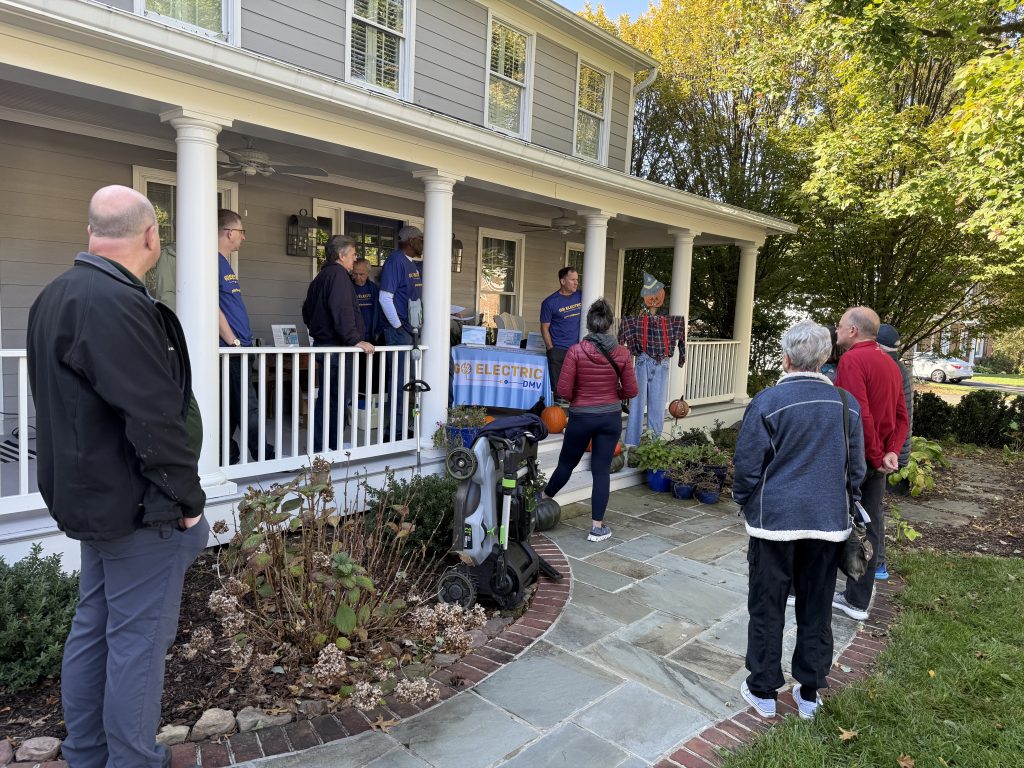
At a Home Electrification Showcase last Saturday, dozens gathered at a home in the Fort Hunt area of Alexandria to learn how to plan to “electrify” their home, fully transitioning away from fossil fuels. The event — hosted by homeowner Bob Soule in partnership with sponsoring organizations the Chesapeake Climate Action Network (CCAN), Citizens’ Climate Lobby, GoElectric DMV, and Rewiring America — aimed to showcase how home electrification can reduce energy costs, cut carbon emissions, and improve indoor air quality while saving money. The event was also promoted by Falls Church Forward and the Falls Church Climate Action Network (FCCAN), both of which held a similar event in the City of Falls Church in July.
The event kicked off outdoors in the home’s front yard, where volunteers discussed the importance of home energy audits and weatherization. A representative from GoElectric DMV explained how these audits can identify gaps in insulation and air leaks, which can be addressed to drastically reduce energy consumption. After a next-door neighbor’s loud, gas-powered lawnmower briefly interrupted the presentation, Soule noted his electric lawnmower, situated nearby, emphasizing how even outdoor tools can be part of the transition to a more sustainable home.
Soule — who is also the founder and an electric coach with Go Electric DMV — then led attendees into his kitchen, where he showcased his induction range and fully-electric oven. Soule emphasized the benefits of induction cooking, noting that it provides superior air quality compared to natural gas ranges. “Using a gas range indoors is like having a smoker in your house,” he said. He further explained that induction cooktops are not only safer—particularly for children, as they produce less surface heat — but also more efficient. “Anything a magnet sticks to can be used on an induction stove,” he added.
Soule did warn homeowners to check for the required 240V outlet behind their current stove before beginning an installation — a lesson he learned the hard way.
The tour then moved to the basement, where Soule discussed his heat pump water heater, electric furnace, and heat pump for home heating and cooling. These systems, once criticized for inefficiency, have made significant advancements. “Heat pumps are now three times more energy efficient than traditional fuel-based systems,” he explained, adding that beyond reducing a home’s carbon footprint, they also provide a cleaner, healthier environment by eliminating the indoor use of fossil fuels like natural gas. In fact, in fully “electrified” homes, carbon monoxide detectors are no longer needed, removing a common health and safety concern.
Moving outside once again, the discussion turned to solar panels. Soule shared that his home is outfitted with a solar array, adding that while home battery systems were considered, he opted instead to settle for net metering. Net metering allows homeowners to return excess energy back to the grid, with energy companies, in return, providing credits to offset the cost of energy use during evenings, days without sufficient sunlight, or other periods of net use.
Several attendees agreed that net metering has proven sufficient for them, noting the dependable local power grid, with most opting to forego a home battery system. In addition, Soule and others noted that, while current home battery systems might provide a few days of power during an outage, electric vehicle (EV) batteries hold significantly more energy — and the technology allowing them to be “plugged in” to a home’s power breaker, replacing the grid. The batteries on today’s EVs could power the average home for nearly a month.
Throughout the event, volunteers from CCAN, Citizens’ Climate Lobby, and Rewiring America discussed how electrification solutions are already widely available and market-ready. According to Soule, “A large portion of the emissions causing climate change are under our control as individuals and homeowners.” Rewiring America estimates that 42 percent of energy-related emissions come from personal choices, including our vehicles and home systems.
Solar panels, induction ranges, and heat pumps are now cost-competitive with fossil fuel-based alternatives. Federal financial incentives, such as those from the Inflation Reduction Act, can make electrification even more affordable. However, attendees were encouraged to plan carefully, seek multiple contractor bids, and phase in replacements over time to maximize savings. For example, while a premium home battery might not be necessary now, installing a larger solar array than what is needed today could future-proof a home, as our energy consumption is expected to continue to increase in coming years.
One major takeaway from the event was that the largest contributors to our carbon footprint is our vehicle, followed by home heating and cooling. Switching to an electric vehicle and replacing a gas furnace with a heat pump can have a profound impact on both emissions and household costs. “Collectively, we can make a big difference,” Soule said. “These technologies are not only better for the environment — they’re better for your wallet and your health.”
The event provided a tangible look at how homeowners can take direct action to reduce their carbon footprint, save money on energy bills, and improve their quality of life. Through partnerships with organizations like CCAN and Rewiring America — and locally through the advocacy of FCCAN and Falls Church Forward — more and more households are choosing to follow Soule’s lead in transitioning away from fossil fuels to a fully “electrified” future.












